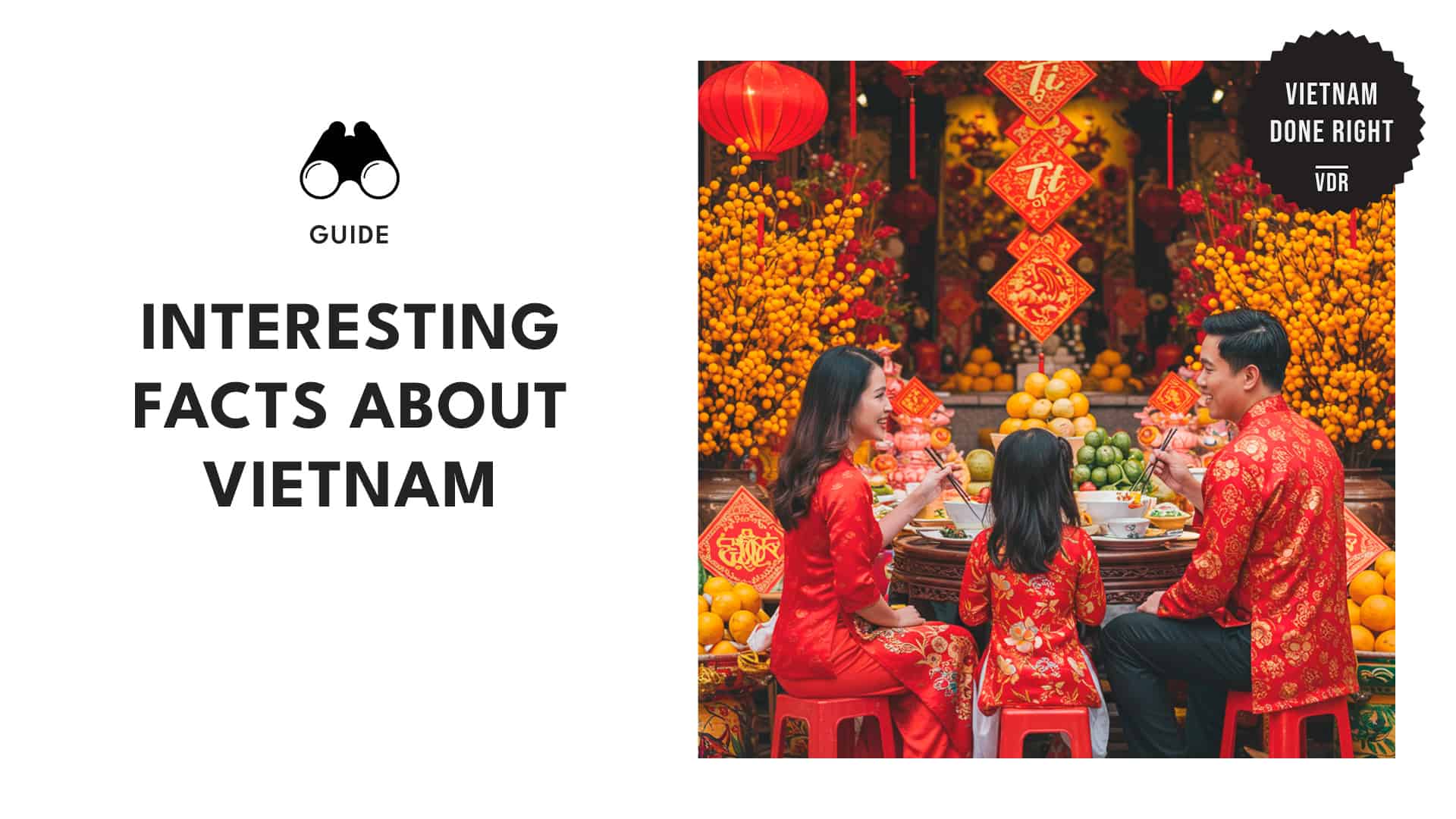10 Interesting Facts About Vietnam That Will Make You Want to Visit
There are places in the world that may seem plain and uninteresting at first, but actually surprise you the more you explore them. That’s what Vietnam is – a humble country rich in history, traditions, and biodiversity, many of which have garnered global recognition.
While many travelers come for the food and the views, it offers more than meets the eye. And if you think you already know this historic country, think again.
Here are some interesting facts about Vietnam that I bet you didn’t know before!
1. Vietnam is the second-largest coffee producer in the world
Media credit: nanoevil
Vietnam is big on coffee. Not only do the Vietnamese prefer their coffee strong, but they are also known for exporting billions of dollars worth of coffee every year.
They reportedly exported around 29 million bags of robusta beans in 2023 alone.
Coffee is deeply ingrained in the daily lives of the people. Coffee shops are known to be everywhere in any city, serving as a communal space for locals to bond, and are now one of the most sought-after delicacies for tourists.
And when we say coffee shops are everywhere, we mean it literally!
In Ho Chi Minh City, there’s a popular establishment known as The Café Apartments. It’s a nine-story residential building that has been transformed into a hub of coffee shops!
Pro tip:
Don’t miss out on trying the egg coffee (cà phê trứng). It’s a Hanoi specialty that blends a creamy egg yolk mixture into your coffee. It gives your coffee a richer and more velvety texture!
2. Vietnam has a rich street food culture
Media credit: curiousaboutvietnam
The origins of Vietnam’s street food culture began in small farming villages in the early 1900s. People created simple yet flavorful dishes using whatever ingredients they had.
These humble beginnings have shaped into one of the attractions that are now part of the checklist of every tourist that visits the country.
The street food scene in Vietnam is vibrant, with lines of vendors offering diverse delicacies from the popular phở to exotic foods like blood soup (Tiết Canh).
Pro tip:
You can try the street food stalls in Hanoi’s Old Quarter or Ho Chi Minh City’s Ben Thanh Market for an authentic experience of the local delicacies.
3. The Conical Hat (Nón Lá) is a cultural icon
Nón Lá, or the conical hat, is a traditional Vietnamese accessory crafted from palm leaves and bamboo. Historically, it was used by farmers for sun and rain protection.
The hat was believed to come from an urban legend about the Rain-Shielding Goddess, who wore this hat when she came down from the sky and taught the people how to grow rice in the rain-soaked fields.
The people then tried to mimic the hat and passed it down to the following generations.
The hat is a big symbol of the country’s identity and is now often used for cultural performances and festivals.
Pro tip:
If you’re interested in learning more about the nón lá, you can visit traditional craft villages like Chuong Village near Hanoi. The artisans there continue to make these hats by hand.
4. Vietnam is home to the largest cave in the world
Media credit: oxalisadventure
In Vietnam lies the largest cave in the world, the Hang Sơn Đoòng. The immense size boasts unique features like towering stalagmites and underground rivers.
It’s really a bucket-list destination for adventurers and nature lovers!
Explorers who visit the cave would often set up camps inside. However, to preserve its condition, access to the cave is limited and must be guided.
Pro tip:
When booking a guided expedition to the cave, make sure you do it in advance through authorized tour operators like Oxalis Adventure.
5. Motorbikes are the most common form of transportation
Media credit: vietnambikers
Motorbikes dominate the streets of Vietnam, with over 58 million motorbikes registered across the country.
The Vietnamese generally prefer motorbikes because they’re significantly cheaper than cars and it’s easier to navigate especially in the middle of traffic congestion, offering a quick and convenient way to travel.
For many locals, motorbikes mean mobility, as it allows them to weave through traffic and reach their destination swiftly.
Pro tip:
If you’re considering renting a motorbike in Vietnam, you typically need a valid driver’s license from your home country. However, many rental agencies may require an International Driving Permit (IDP).
6. Vietnam has 54 ethnic groups
Media credit: julieannedaviesphoto
Vietnam officially recognizes 54 ethnic groups, with the Kinh people making up the majority. These groups significantly enrich the country’s cultural heritage with distinct languages, traditions, and customs.
These communities can be primarily found in the mountainous and rural regions, where they celebrate colorful festivals, weave intricate textiles, and each has its unique architectural styles.
Exploring these highland villages and engaging with these communities can give you an authentic and mind-opening cultural experience.
Pro tip:
If you plan to visit the Central Highlands or areas like Sa Pa, consider participating in community-based tourism initiatives to support local livelihoods and experience immersive cultural exchanges.
7. Water puppetry is a unique art form
Media credit: Sun Getaways Vietnam Travel
Water puppetry or locally known as Múa rối nước, is one of the traditional Vietnamese art forms that dates back to the 11th century during the Lý Dynasty. It was originally performed in rice paddies and ponds.
In today’s time, it’s commonly performed in theaters with a waist-deep pool of water.
Puppeteers would maneuver the puppets using long bamboo rods hidden from the water surface, which creates an illusion of the puppets dancing on water. It would often depict scenes from Vietnamese folklore and history, accompanied by live folk music.
Vietnam now holds over 500 shows every year!
Pro tip:
The most popular venue for puppet shows in Vietnam is at the Thang Long Water Puppet Theater in Hanoi.
8. Vietnam is the world’s largest exporter of cashew nuts
Media credit: kimmyfarmvietnam
Currently known as the “King of Cashew Nuts for Exports”, Vietnam accounts for about 60% of global exports – making it the leading producer for the last 17 years.
This stretches to various worldwide markets, including the United States and Europe.
Not only does this boost Vietnam’s economy, but it also provides great employment opportunities for the locals.
Pro tip:
Visit the local cashew farm in Bình Phước province– Vietnam’s cashew capital. You’ll get a firsthand look at how cashews are harvested and processed.
9. Tết is the most important celebration in Vietnam
Media credit: vietnamtravelers
Tết or Tết Nguyên Đán is Vietnam’s most important holiday, marking the Lunar New Year and the arrival of spring– usually falling between late January and early February in the normal calendar.
It’s a time for families to gather and honor their ancestors. The streets come alive with various markets and traditional music performances.
One popular tradition is giving money in red envelopes – typically from elders to children, as it symbolizes good fortune for the coming year.
Pro Tip:
Don’t hesitate to interact with the locals! Learning a few Vietnamese phrases like Chúc mừng năm mới (pronounced Chook moong nahm moi – translated to Happy New Year) can go a long way in making connections!
10. The country has eight UNESCO World Heritage sites
Media credit: ahmad.aldabagh
If there’s one thing that Vietnam brags about the most, it’s the fact that the country is home to eight UNESCO World Heritage sites.
These include five cultural sites, two natural sites, and one mixed site.
Each site offers a unique perspective of Vietnam’s rich history and biodiversity.
For example, Hạ Long Bay is popular for its emerald waters, while Hội An Ancient Town boasts the well-preserved architecture that dates back to the 15th century.
To fully appreciate these sites, we suggest considering guided tours that offer context to learn more about the history.
Pro tip:
Some heritage sites may have preservation zones where photography is limited or visiting may require advance booking. Check the official UNESCO or Vietnam tourist website for specific regulations.


